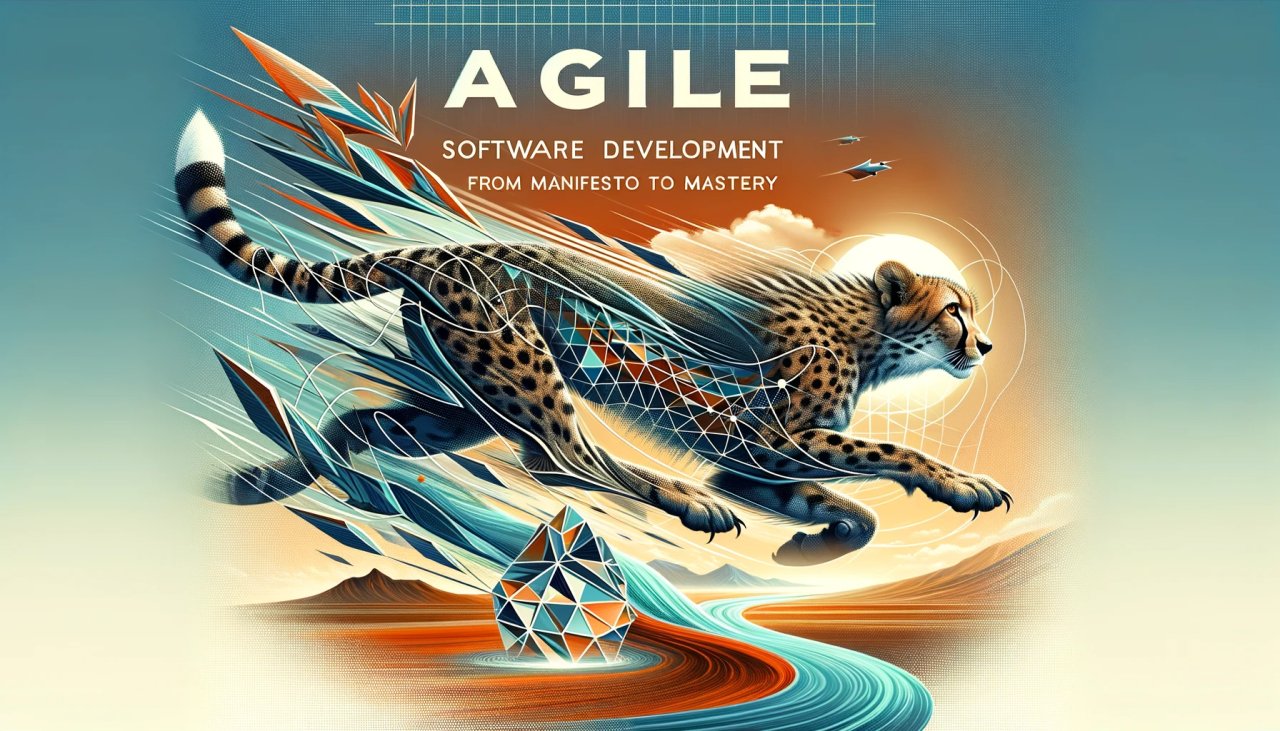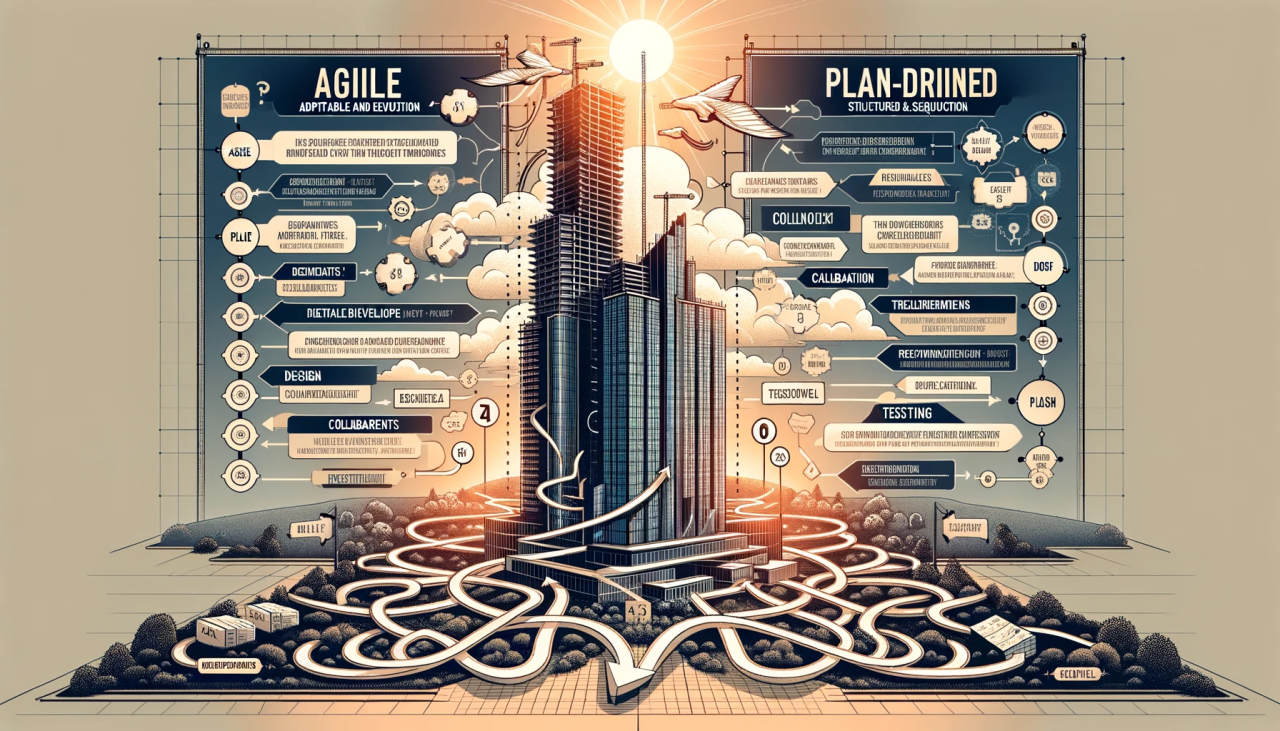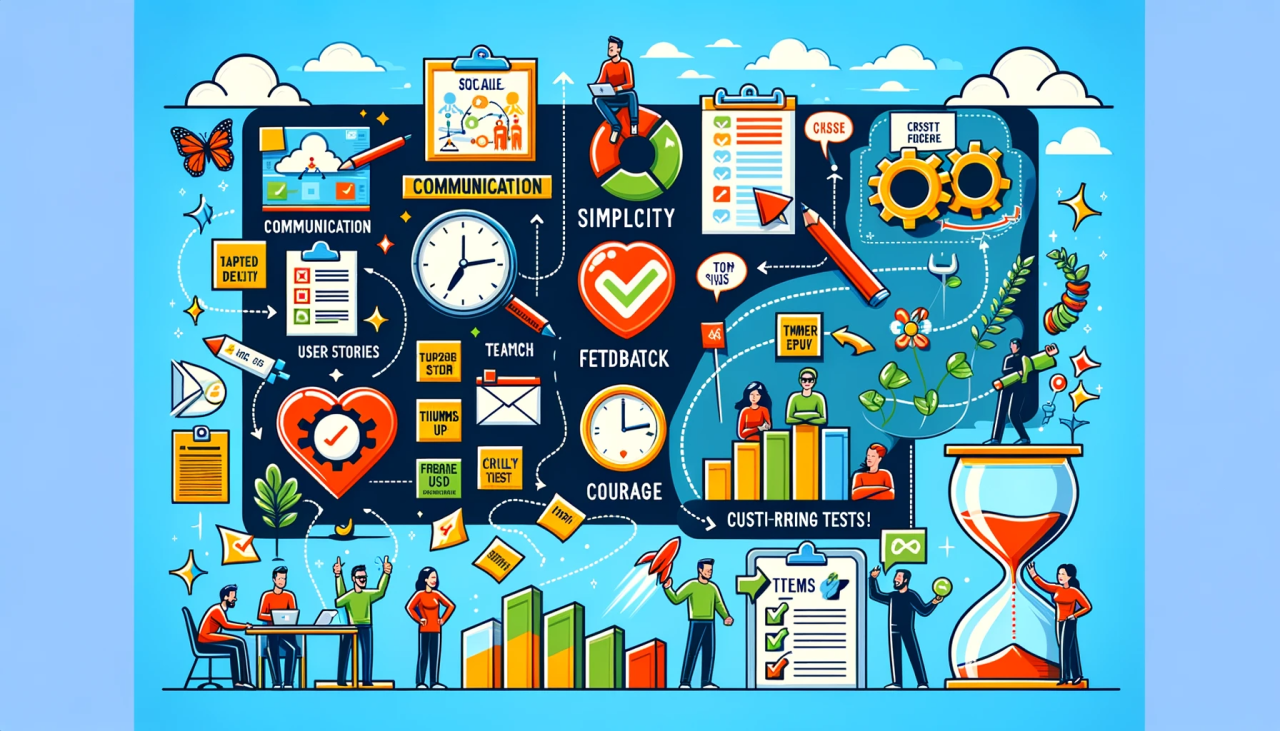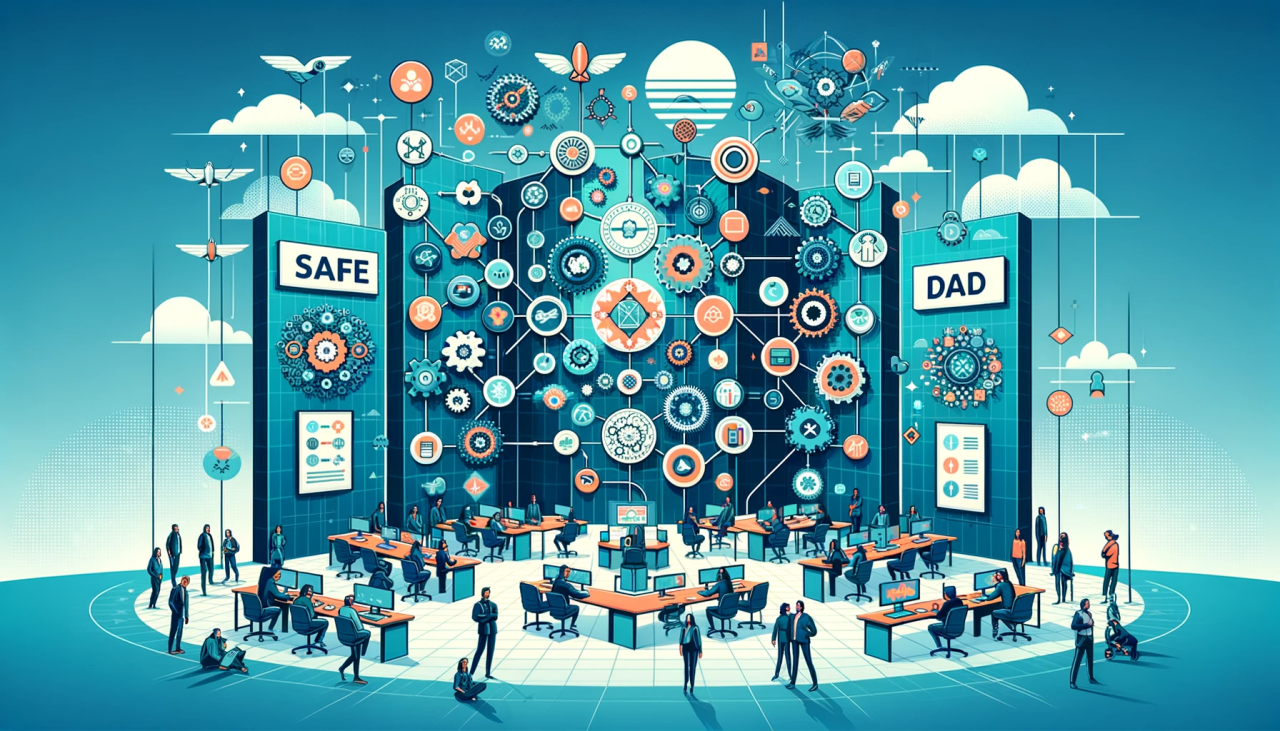Agile Software Development#

Overview#
Introduction to Agile Software Development
Definition and Core Principles
The Agile Manifesto
Rationale for Agile Methods
Agile vs Plan-Driven Development
Comparative Analysis
Situational Applicability
Agile Development Techniques
Key Practices and Techniques
User Stories and Timeboxing
Continuous Integration and Test-Driven Development
Agile Project Management
Overview of Agile Project Management
The Scrum Framework
Roles and Ceremonies in Scrum
Scaling Agile Methods
Challenges in Scaling
Frameworks for Scaling Agile (e.g., SAFe, LeSS, DaD)
Case Studies and Best Practices
Conclusion
Summary of Key Points
Future of Agile Methodologies
Introduction to Agile Software Development#

Agile Software Development is a methodology that promotes continuous iteration of development and testing throughout the software development lifecycle of the project. Unlike traditional software development like the Waterfall model, Agile processes integrate planning with execution, allowing for flexible and rapid response to change, which is a fundamental aspect in the tech industry today.
The core principles of Agile are derived from the Agile Manifesto, a formal proclamation of four fundamental values and twelve supporting principles that guide Agile project management. These values emphasize individuals and interactions over processes and tools, working software over comprehensive documentation, customer collaboration over contract negotiation, and responding to change over following a plan.
The rationale behind Agile methods includes customer satisfaction through early and continuous delivery, embracing change, delivering working software frequently, and encouraging face-to-face conversation. It’s about building projects around motivated individuals, giving them the environment and support they need, and trusting them to get the job done.
Agile is an iterative and incremental approach to software design.
The Agile Manifesto is the foundational document for Agile development.
Agile methods facilitate flexibility and adaptability in the development process.
Emphasizes direct communication and collaboration, rapid prototyping, and short feedback loops.
By focusing on the fluidity of development and being open to changing requirements, even late in the development cycle, Agile methodology champions a customer-centric approach that significantly reduces the overall risk associated with software development.
Agile vs Plan-Driven Development#

When comparing Agile and Plan-Driven Development (often referred to as the Waterfall model), the distinctions primarily lie in their approaches to planning, execution, and adaptability. Plan-Driven Development adheres to a sequential design process, often linear and phase-based, where progress flows largely in one direction—“downwards” like a waterfall—through the phases of conception, initiation, analysis, design, construction, testing, deployment, and maintenance.
In contrast, Agile Development is iterative and incremental, promoting a flexible and collaborative approach. The focus is on delivering small, workable segments of software early and often, enabling continuous feedback and adaptation. Agile methodologies, such as Scrum, Kanban, and Extreme Programming (XP), emphasize direct collaboration with stakeholders, adaptive planning, evolutionary development, early delivery, and continual improvement, and they encourage rapid and flexible response to change.
While Plan-Driven Development can provide a structured and disciplined approach for large projects with clear requirements, Agile is favored for projects where requirements are expected to change or are not fully understood at the outset.
Sequential vs Iterative: Waterfall is linear, Agile is cyclic.
Flexibility: Agile accommodates change, Plan-Driven is more rigid.
Stakeholder Engagement: Agile involves continuous stakeholder collaboration, while Plan-Driven often limits stakeholder engagement to specific milestones.
Delivery Focus: Agile focuses on frequent delivery of working software, whereas Plan-Driven often has one major release after a long development period.
The choice between Agile and Plan-Driven Development should be informed by the project context, requirements stability, team size, and customer involvement, among other factors. Agile is not inherently superior to Plan-Driven; the best approach depends on the specific circumstances of the project.
Agile Development Techniques#

Emphasis on communication, simplicity, feedback, and courage in techniques.
User stories create a user-focused framework for defining features.
Timeboxing limits work to a fixed duration to encourage frequent reassessment and adaptation.
Continuous Integration and Test-Driven Development foster a stable and quality codebase through continuous testing and integration.
These techniques help Agile teams maintain focus on delivering value to the customer, adapt to changing requirements, and ensure a high-quality product through frequent assessments and iterations.
Key Practices and Techniques#
Agile development is characterized by a collection of key practices and techniques that support its principles. These include regular stand-up meetings to synchronize team efforts, pair programming for quality code, refactoring to improve existing code, and sprint reviews for iterative evaluation. Techniques like automated testing and continuous integration ensure that the software is always in a potentially shippable state.
User Stories and Timeboxing#
User Stories and Timeboxing are two pivotal elements in Agile. User stories are short, simple descriptions of a feature told from the perspective of the user or customer. They are the primary method by which the team understands the user’s needs. Timeboxing is a time management technique that assigns a fixed, maximum unit of time for an activity, such as a sprint in Scrum, ensuring that work is reviewed and lessons are integrated regularly.
Continuous Integration and Test-Driven Development#
Continuous Integration (CI) and Test-Driven Development (TDD) are practices aimed at maintaining a high quality of code and ensuring that changes work as expected. CI involves merging all developer working copies to a shared mainline several times a day, while TDD encourages writing tests before the actual code, thus ensuring that code only contains features for which there is a test.
Agile Project Management#

Agile Project Management is a flexible and iterative approach that allows overlapping development phases.
Scrum is a popular framework within Agile that focuses on delivering value quickly and efficiently.
Scrum Roles include the Product Owner, Scrum Master, and Development Team.
Scrum Ceremonies guide the collaborative and iterative work flow and include planning, daily stand-ups, reviews, and retrospectives.
The agile project management style fosters a collaborative environment that values team input and aims to deliver high-quality products in a timely manner by dividing tasks into short, manageable sprints.
Overview of Agile Project Management#
Agile Project Management (APM) is an iterative approach to planning and guiding project processes. Just as in Agile Software Development, APM involves breaking projects into small pieces that are completed in work sessions, ranging from the design phase to testing and quality assurance. Unlike traditional project management, APM does not require the completion of one phase to start another; phases often overlap, which results in a faster, more fluid project flow.
The Scrum Framework#
The Scrum Framework is a subset of Agile and one of the most popular process frameworks for implementing Agile. It is an adaptive, iterative, fast, flexible, and effective methodology designed to deliver significant value quickly and throughout a project. Scrum ensures transparency in communication and creates an environment of collective accountability and continuous progress. The Scrum framework begins with a backlog, or a list of work to be done. Tasks are then divided into sprints, or short work periods.
Roles and Ceremonies in Scrum#
Roles and Ceremonies in Scrum are pivotal for the function of Scrum. Key roles include the Product Owner, who represents stakeholders and the voice of the customer; the Scrum Master, who ensures the team follows Agile practices; and the Development Team, who work together to deliver the product increments. The main ceremonies within Scrum are the Sprint Planning, which sets up the work to be performed during the sprint; Daily Stand-Up meetings for status updates; Sprint Review, to present the work done; and Sprint Retrospective, where the team reflects on the past sprint and makes adjustments for the next one.
Scaling Agile Methods#

Scaling Agile methods refers to the process of applying Agile principles and practices to large projects, multiple teams, and complex systems. As organizations grow, they often find that the Agile practices that worked for small, co-located teams need to be adapted to suit the increased scale of their operations.
Challenges in scaling include communication, coordination, and maintaining the Agile culture across multiple teams.
Frameworks like SAFe, LeSS, and DaD offer structured approaches to scaling Agile.
Success in scaling Agile methods can be achieved by combining framework adoption with a commitment to Agile principles and continuous improvement.
Organizations looking to scale Agile methods must carefully consider their unique contexts and constraints, and be prepared to adapt the chosen framework to suit their needs. It’s a complex process, but when done correctly, it can lead to significant improvements in efficiency, quality, and team morale.
Challenges in Scaling#
Challenges in Scaling include maintaining effective communication and coordination across multiple teams, ensuring consistent application of Agile methods, and dealing with the increased complexity of larger products and systems. As the number of stakeholders grows, so does the need for more structured planning and coordination. The cultural shift required to embrace Agile across multiple departments can also be significant.
Frameworks for Scaling Agile#
Frameworks for Scaling Agile have been developed to address these challenges. The Scaled Agile Framework (SAFe) provides a template for applying Agile and Lean practices at enterprise scale. Large-Scale Scrum (LeSS) is a framework that applies the principles and practices of Scrum in a large-scale context. The Disciplined Agile Delivery (DaD) framework provides a more disciplined approach to Agile by incorporating a range of Agile practices from Scrum, Kanban, and other methods, tailored to the organization’s context.
Case Studies and Best Practices#
Case Studies and Best Practices show that successful scaling often involves a combination of adopting these frameworks with a firm commitment to Agile values and principles. Best practices include incremental adoption, frequent retrospectives at scale, and ensuring a strong foundation of Agile practices at the team level before scaling.
Conclusion#
The journey through Agile Software Development reveals a transformative approach to creating software that prioritizes flexibility, collaboration, and customer satisfaction. Agile methodologies break from the rigidity of traditional models, offering a dynamic framework that responds to change and values human communication over exhaustive documentation.
Summary of Key Points#
Agile methodologies champion iterative development, customer collaboration, and adaptability.
Scrum, as an Agile framework, provides a structure for frequent reassessment and team-based development through defined roles and ceremonies.
Scaling Agile requires additional frameworks like SAFe, LeSS, and DaD to manage the complexities of larger teams and projects while maintaining core Agile principles.
Challenges in scaling Agile revolve around communication, maintaining culture, and coordination across teams.
Future of Agile Methodologies#
Agile methodologies are poised to continue evolving. The emphasis on continuous improvement and adaptation to change suggests Agile principles may be integrated into areas beyond software development, including business and management practices. The future of Agile lies in its ability to stay relevant and resilient in the face of changing technology and market demands.